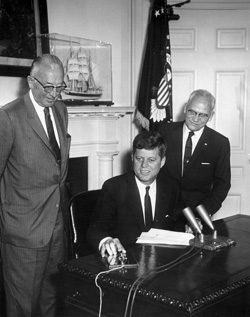By John Karoly
Chicago, IL, USA
21 June 1961: A black button was placed on the President’s desk in the Oval Office of the White House. The press, government officials and industry officials were invited to witness President John F. Kennedy’s “remote dedication of the Nation’s First Saline Water Conversion Plant,” accomplished by his pressing of the button. More significantly, he spoke of the importance of desalination and the long-range importance to humanity of producing fresh water from seawater at an economically competitive price. The button was connected to absolutely nothing.

John Karoly
|
At that moment in Freeport, Texas, I was running that first Saline Water Conversion Plant, almost oblivious to the events in Washington. We had to run ourselves nearly ragged to operate the plant that occupied something on the order of a city block, was about eight stories high and was built without an elevator. I did not appreciate then, as I do now, what had transpired up to the point of the President’s ceremonial dedication and why it was the best that could be done to get the participation of a busy President. And, at the same time to get the nation, if only for a moment, to focus on a problem only a few were able to identify as a major issue for the US and for the world - the future shortage of potable water. Let’s go back in history.
The “Desalinization Program” was authorized by the Department of the Interior in July, 1952. Although earlier discussions for the production of fresh water from seawater had taken place, the first meaningful legislation was proposed by the Secretary of the Interior, Stuart Udall, and others in his department who were able to identify a serious future problem for the country. It took some 30 years before the problem started to show up in our everyday lives. Later, that Administration added “Water Pollution Control” to the Saline Water Conversion Act, again ahead of the times. Few realized the importance of water pollution in those days.
It was with this foresight that the OSW (Office of Saline Water) was formed under the jurisdiction of the Department of the Interior in September, 1955, with the stated purpose to administer research and development in the area of desalination. It was under the auspices of the OSW that the first demonstration plant was built in Freeport. It used steam as an energy source and it was designed to test what was then high efficiency energy utilization. Udall must have convinced the President to be part of it, and presumably, the President agreed if he did not have to travel away from Washington.
After Freeport, I was involved with the building of the second and last large-scale demonstration plant under the OSW in Roswell, N.M. The plant was designed for brackish water and to use electricity rather than steam as a power source. The compressor that drove the plant (imagine a very large jet engine) was so powerful that when we put the plant online at night, the lights of Roswell dimmed from the power surge of the compressor motor. That was fun!
The OSW functioned for quite a few years after Roswell, running these plants and working on a few other technologies. The agency was abolished in July, 1974. The problem was certainly not that they were behind the times, but rather that they were far ahead, and that the country did not keep up with them. Too bad.

President Kennedy Presses the Black Button,
June 21,1961
|
At the time of Freeport, there were probably no more than a few hundred people involved with desalination technology around the world. Today the organization that follows the development of such technology is the International Desalination Association (IDA) with 2,400 members in 60 countries, plus an additional 4,000 members in affiliated organizations. Saline water conversion is a very important technology for generating potable water. Many people around the world (estimated close to two billion) don’t have access to pure water and live only on contaminated water, breeding illnesses and causing early deaths. Globally, the number and capacity of the desalination plants is increasing each year, but we are only scratching the surface when we look at the ever-increasing need for pure water.
Almost 60 years after some very bright and alert members of the US government first thought about desalination, we are still in the infancy of the use of seawater conversion for our potable water needs. However, and this is a very important “however,” we are getting very close to the objective stated by President Kennedy during the dedication - producing fresh water from seawater at a commercially competitive price!
I hope that, in spite of the very sad behavior of our current government and its pitiful politicians, there are still bright people with foresight in the various governmental departments who can lead the way, as their predecessors did, to the future needs of our people and the peoples of the world.

